|
|
|||||||||
|
|
|||||||||
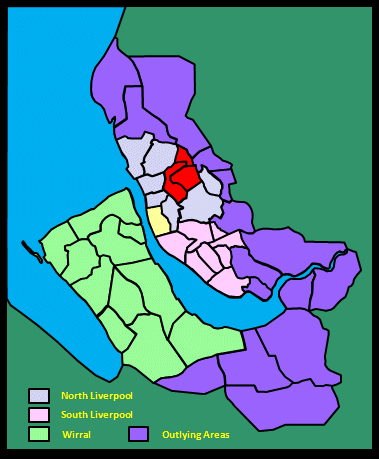 |
| CLICK A BOOTPRINT FOR A RELEVANT WALK - LINKS TO OTHER SITES AT THE BOTTOM OF THE PAGE |
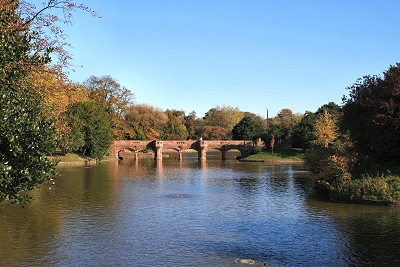 |
The Lake, Stanley Park, Anfield The original design of 1866 of Stanley Park was by Edward Kemp, a pioneer of public park design, and extensive restoration work completed in 2009 has followed his plans. The major features of the park are the conservatory, the sandstone terraces and the lakes, each complementing and providing a contrast with each other. |
|
 |
The Formal Gardens, Stanley Park, Anfield The highest part of Stanley Park is the most formal, with sandstone pavilions, flower beds and a rose garden. Kemp's design created an open area below the terraces, with the effect of creating space around them and adding to their splendour, opening up the view and leading the eye to the lakes and the suburbs beyond. |
|
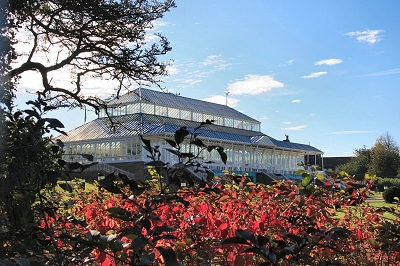 |
The Conservatory, Stanley Park, Anfield The conservatory in Stanley Park, originally named the Gladstone Conservatory in honour William Gladstone, was completed in 1900 and constructed of cast and wrought iron by Mackenzie and Moncur of Edinburgh (who also built Sefton Park Palm House). It fell into disrepair in the 1950s and was re-built in 2009, when it was renamed the Isla Gladstone Conservatory as a tribute to the turn of the 20th century textile designer, gardener and artist of the Arts & Crafts movement. |
|
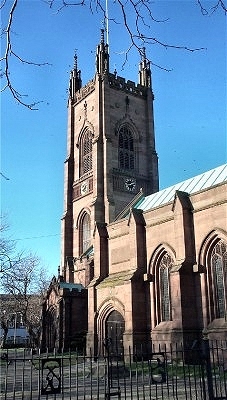 |
St. Mary's Church, Walton The ancient area of Walton was much larger than the present one. Childwall was detached before the Norman Conquest and Sefton before 1200. Liverpool was relatively insignificant at that time and only separated in 1699. The site and foundations of the church are ancient and a church is mentioned in the Domesday Book. Before 1699, it was the principal church of Liverpool, St Nicholas's having been a chapel of Walton up to that time. Parts of the present church date from 1743, when the nave was rebuilt, but the north side was remodelled in 1840. The chancel dates from 1843 and the tower from 1832. The atmospheric churchyard features an early 18th century sundial. |
|
| Walton in Lewis's Topographical Dictionary of England (1848) This locality presents an extremely pleasing appearance, and abounds in handsome mansions and villas; from Walton Hill are most extensive views, including the town of Liverpool, the Welsh hills, and the mountains of Cumberland. Among the best houses are Walton Hall, the residence of Richard Naylor, Esq.; Walton Priory, that of Robert Ellison Harvey, Esq.; and several detached mansions on Breeze Hill. On the side of the Ormskirk road is the unique establishment of Charles Whitfield Harvey, Esq., the successful rearer of prize-cattle; and Spellow House, an ancient mansion of stone, is surrounded by a large tract of land, appropriated by Mr. William Skirving to the rearing of foresttrees and nursery-plants in general, including those of the most rare description. [...] The church, which, up to 1698, was the mother church of Liverpool, was mostly rebuilt in 1829, at a cost of £5000; and is a noble structure in the early English style, with decorated portions, and a tower and pinnacles. From its great elevation, it is a conspicuous object in the surrounding scenery, and serves as a landmark. The interior is very beautiful, with a stained-wood roof, and east and west windows of painted glass. |
||
| Walton in the Victoria History of the County of Lancaster (1907) The natural features of the township have long since been obscured or entirely swept away by bricks and mortar, and thronged streets of small houses and busy shops and electric-car standards occupy the site of country lanes, gardens, and trees. [...] The old village lay near the church, in a street bending round its northern side. The workhouse of the West Derby Union lies about a mile to the north; close by is a cemetery belonging to the parish of Liverpool. Farther north still is the county prison; here executions take place. |
||
| Walton in Liverpool (1907) by Dixon Scott Walton, to my mind, stands as a perfect embodiment of all the mingled tragedy and triumph of this great process of suburb overthrow. For centuries her Church was the proud hub of the parish in which Liverpool was but an inconsiderable hamlet. [...] There is little pride left to the old Church now. It stands, bleak and friendless, in the midst of a dull pool of gravestones; smoke from a railway siding blackens its walls; the cars roar triumphantly past its very gates; it has been compelled to guard its dead with rows of iron railings. In the lanes that cower behind it, too, defeat is equally apparent: scraps of villagedom hunted down by a rabble of red-faced tenements; a mass of garish brick squatting blatantly in the ruins of a cornfield; [...] the old Hall, in its nest of trees, lying fouled and rifled. In the shadow of the Church there is a little cottage that has the reputation, significantly enough, of being the only thatched cottage in Liverpool. It is delicately complexioned, daintily windowed, and altogether very fragrant and delightful. But the poor soul, one fancies, is not long for this world. But just beside the Church one gets the modern touch that seems to make amends. It is from here that the great new road [that is, Walton Hall Avenue] - wide, much-foliaged, grass-platted - begins the journey which is to result in a curving band of ordered white and green being drawn right through the mass of eastern suburbs: a noble avenue which posterity will pace delightedly, thinking kind thoughts of 1907. [...] Thatch, after all, is not the final excellence of life. |
||
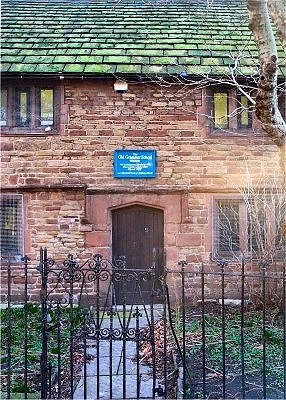 |
The Old School House, Walton Tucked away at the side of St Mary's church, the old grammar school is dated 1613 and replaces an earlier school of 1548. |
|
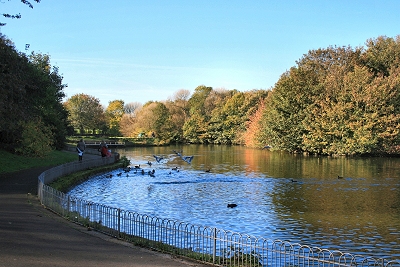 |
The Lake, Walton Hall Park, Walton The 130 acre (52 ha) Walton Hall Park dates back to 1199, when Henry de Walton was steward of the West Derby Hundred. The last Walton Hall was demolished in the early years of the 20th century. The Estate was opened as a public park in 1934 by King George V on the same day as he opened the Mersey Tunnel (Queensway). The lake existed at least as far back as the 18th century. It shown on a map of 1768 as being called Dig Lake, at that time lying on the course of Tue Brook. |
|
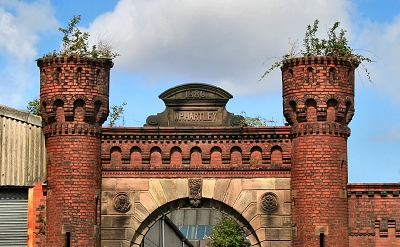 |
Main Gate, Hartley's Factory, Aintree Hartley's Village was roughly contemporaneous with Port Sunlight Village. In 1888 Sir William Pickles Hartley (1846-1922) of the Hartley's Jams and Marmalade Company held a competition for a 5 acre (2 ha) workers' housing project next to his new factory in Aintree. The firm of William Sugden and Son were selected to design a block of houses surrounding a central green, described in 1905 as 'a square of neat cottages with small gardens in front, facing four roads, and surrounding an open garden and playground square'. Hartley was born in Colne, Lancashire. The family began with a local grocers shop and then moved into the wholesale trade. The legend has it that a supplier failed to deliver a batch of jam and Hartley was forced to make his own, which sold so well that he continued to make it, packaging it in his own distinctive earthenware pots. In 1884 the business was incorporated as William Hartley & Son Limited and in 1885 he moved it to Aintree, where he subsequently built the village for his workers. In 1902 he opened a jam factory in Bermondsey, London, employing over 2,000 people. Throughout his life, he donated money for religious or philanthropic causes in Colne, Liverpool and in London. Many buildings in Colne, built in 1911, still stand and are known locally as Hartley Homes. |
|
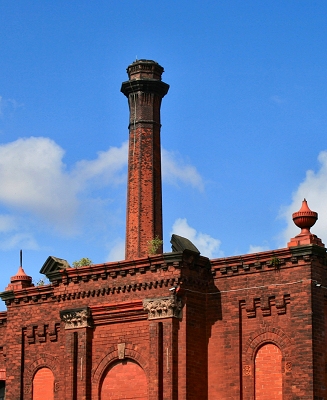 |
Hartley's Factory, Aintree | |
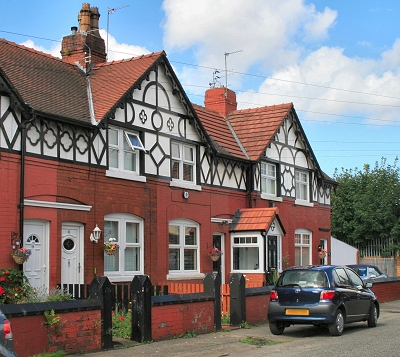 |
Hartley's Village, Aintree Hartley's Village started with 40 houses and later expanded. In the square behind the houses were gardens, tennis courts and bowling greens for the resident workers to enjoy. Most of the roads in the village were tree-lined avenues with names of the ingredients used in jam-making such as Sugar Street, Spice Lane and Cherry Avenue; only the Spice Street name seems to have survived. An old postcard talks about: 'the Garden Village [...] situated in the midst of trees, fields and perfectly healthy surroundings. The fruit is brought right into the works daily by special trains from the Hartley Fruit Farms. Fruit gathered at sunrise is Hartley's Jam the same evening.' |
|
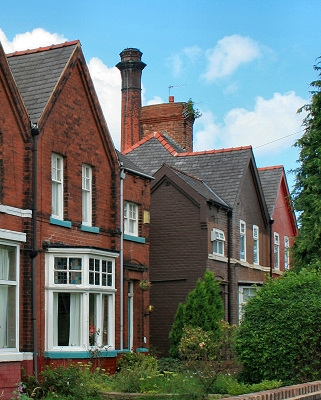 |
Hartley's Village, Aintree The houses are now privately owned and still retain much of their charm and character, although the green spaces have long since gone and the factory remains are derelict. The Hartley's Village Heritage Council residents' group exists to reverse the decline of the village and restore the surrounding area, but it is acknowledged that this will be a long and difficult process. In 2011 the village was granted Conservation Status. |
|
| Fazakerley in the Victoria History of the County of Lancaster (1907) In the thirteenth century Fazakerley was one of the Walton town fields, adjoining which, as the woodlands were cleared, there grew up a hamlet and ultimately a township. It is separated from Walton by the brook called Fazakerley or Tue Brook, and from West Derby partly by Sugar Brook up to the point where it is spanned by Stone bridge. [...] The country is extremely flat and treeless, with nothing to recommend it to the passer-by, for it seems to be a district of straight lines, devoid of any beauty. Rather bare fields on the south and east under mixed cultivation give some variety to the pasture land. [...] Agriculture is the chief occupation, but the jam works established here have attained considerable magnitude, and on the Aintree border have given name to a little town known as Hartley's Village. |
||
| Aintree in the Victoria History of the County of Lancaster (1907) The country is extremely flat, and in the northern portion of the township the level of the landscape is scarcely broken by even the smallest trees, and the hedges are but scanty. The surface, occupied by cultivated fields, where corn and potatoes find a congenial soil, is a mixture of clay and sand. A few farms are dotted about the district. [...] The great racecourse, was opened 8 July, 1829. The old village is in the centre of the township, about two miles south-east of Sefton church; but houses are multiplying on the Walton border, owing to the growth of Liverpool and the rise of industries in the neighbourhood. |
||